Last updated: January 23, 2025
Article
The Octagon of Washington, D.C.: The House that Helped Build a Capital (Teaching with Historic Places)
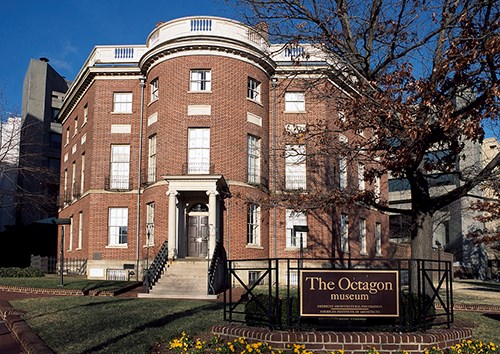
This lesson is part of the National Park Service’s Teaching with Historic Places (TwHP) program.
In late afternoon on August 24, 1814, the First Lady Dolley Madison frantically worked to save the White House’s treasures. With very little time left as the British Army marched in to sack the new capital, she managed to escape with precious works of American art before the enemy arrived to burn down the White House.
The British occupation of Washington, D.C. lasted only 26 hours, but upon President Madison's return to the city, the White House was in no shape to live in. Though there were calls to move the capital from Washington, D.C., the Madisons refused. President Madison and Dolley Madison took up residence in The Octagon, one of Washington's first great houses, located close to the White House at the corner of 18th Street and New York Avenue. From The Octagon, the president ran his administration and the first lady ran Washington society.
The Octagon was a suitable home for a president. Completed in 1801, it was a winter residence for an eminent Virginian planter, Colonel John Tayloe III, and his family. Dr. William Thornton, the first architect of the U.S. Capitol, designed the house and gave the growing federal city a grand home to help build Washington's reputation. Owned by the American Institute of Architects Foundation today, The Octagon can transport visitors to the early years of the United States, when Washington, D.C., was a small, rural community with great expectations.About This Lesson
This lesson is based on the National Historic Landmark registration form, “The Octagon (Colonel John Tayloe House)” (with photographs), and materials from The Octagon Museum Archives. It was written by Adam Auerbach, American Institute of Architects Foundation intern at The Octagon Museum, and edited by Teaching with Historic Places staff in consultation with Katherine Somerville, the Director of Programs at The Octagon. This lesson is one in a series that brings the important stories of historic places into classrooms across the country.
Where it fits into the curriculum
Topics: The lesson could be used in units in United States history on politics and society in the Early Republic, the War of 1812, and the creation of Washington, D.C.
Time period: Late 18th century to early 19th century
United States History Standards for Grades 5-12
The Octagon of Washington, D.C.: The House that Helped Build a Capital
relates to the following National Standards for History:
Era 3: Revolution and the New Nation (1754-1820s)
-
Standard 2B: The student understands the economic issues arising out of the Revolution.
Era 4: Expansion and Reform (1801-1861)
-
Standard 2B: The student understands the first era of American urbanization.
-
Standard 3B: The student understands how the debates over slavery influenced politics and sectionalism.
Curriculum Standards for Social Studies
National Council for the Social Studies
The Octagon of Washington, D.C.: The House that Helped Build a Capital
relates to the following Social Studies Standards:
Theme I: Culture
-
Standard C - The student explains and gives examples of how language, literature, the arts, architecture, other artifacts, traditions, beliefs, values, and behaviors contribute to the development and transmission of culture.
Theme III: People, Places, and Environments
-
Standard G - The student describes how people create places that reflect cultural values and ideals as they build neighborhoods, parks, shopping centers, and the like.
Theme V: Individuals, Groups, and Institutions
-
Standard A - The student demonstrates an understanding of concepts such as role, status, and social class in describing the interactions of individuals and social groups.
Theme X: Civic Ideals and Practices
-
Standard C - The student locates, accesses, analyzes, organizes, and applies information about selected public issues--recognizing and explaining multiple points of view.
-
Standard F - The student identifies and explains the roles of formal and informal political actors in influencing and shaping public policy and decision-making.
Objectives for students
1) To summarize the challenges to establishing a United States capital and describe how Americans overcame those challenges;
2) To explain the significance of The Octagon in early U.S. history and the ways it contributed to the success of Washington, D.C.;
3) To describe early Washington, D.C., by researching a historical perspective and writing a letter from that perspective;
4) To identify a local historic building and explain how it contributed to your community's growth and identity.
Materials for students
The materials listed below can be used directly on the computer or can be printed out, photocopied, and distributed to students. The maps and images appear twice: in a smaller, low-resolution version with associated questions and alone in a larger version.
1) Two maps of the United States in the late 18th century and of The Octagon’s location in 21st century Washington, D.C.;
2) Four readings about the creation of the U.S. capital, early Washington, D.C., The Octagon, and the Tayloe family, including two primary documents;
3) Four images of one 1813 painting of The Octagon in rural Washington, D.C., a drawing of The Octagon’s first-floor plans, and two photographs of The Octagon dining room and of The Octagon exterior.
Visiting the site
The Octagon Historic House Museum, owned by the American Institute of Architects Foundation, is located at 1799 New York Avenue NW in Washington, D.C. The museum is open Thursday and Friday, from 1pm-4pm year-round, and also on Wednesdays during the summer. The Octagon does not charge an admittance fee. The Octagon is within walking distance of the Farragut West and Farragut North metro stations.
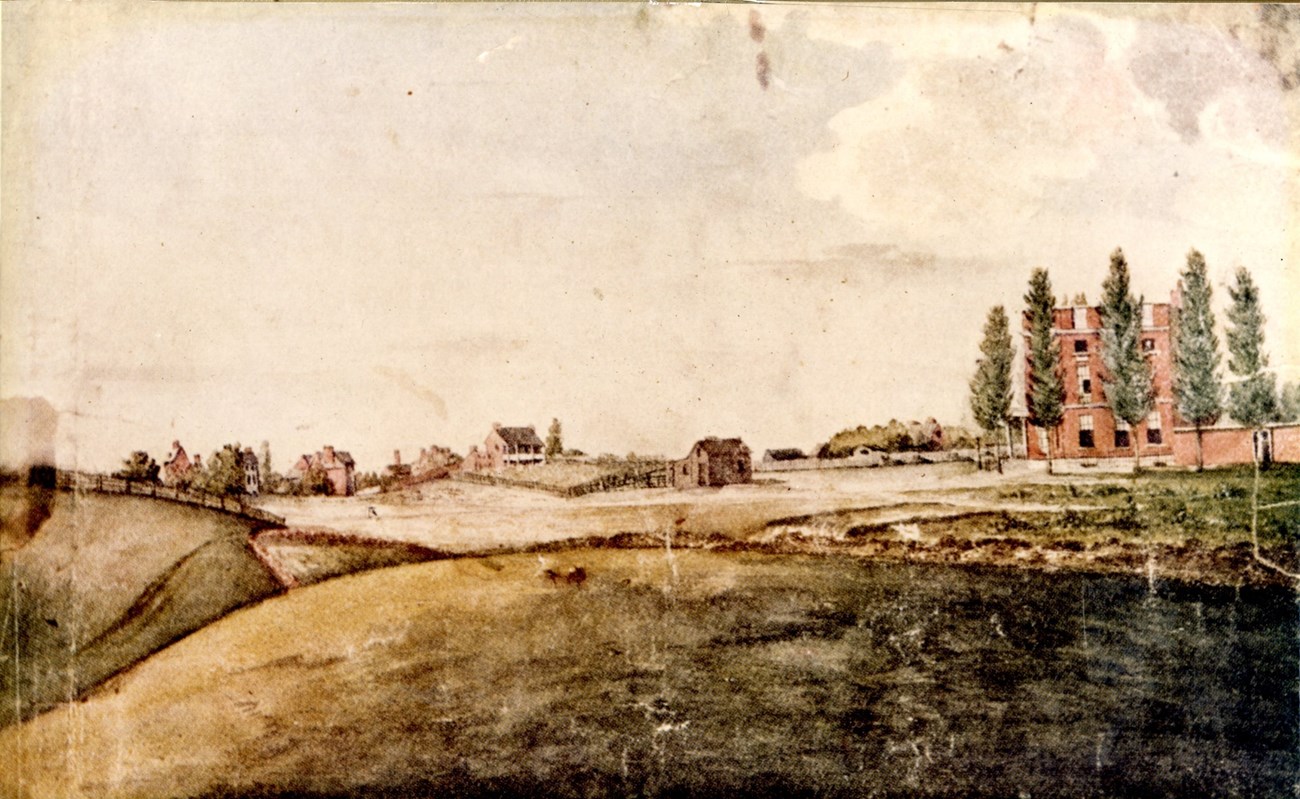
What kind of place do you think this painting depicts?
Setting the Stage
|
After the states declared independence from Britain in 1776, their collective American government moved around the mid-Atlantic region until it settled farther south in Washington, D.C., in 1800. Philadelphia is well-known for its early role as host to the Continental Congresses, but states sent their representatives to capitals set up in eight different cities. Like the First Continental Congress, the Second Continental Congress met in Philadelphia. It also met in York and Lancaster, both in Pennsylvania, as well as in Baltimore, Maryland. After the Revolutionary War, the Congress under the Articles of Confederation met in Philadelphia and also in Princeton, New Jersey; Annapolis, Maryland; Trenton, New Jersey; and New York City. It was in New York that the states ratified the U.S. Constitution. For ten years afterward, between 1790 and 1800, the government met in Philadelphia before it settled permanently in Washington, D.C. |
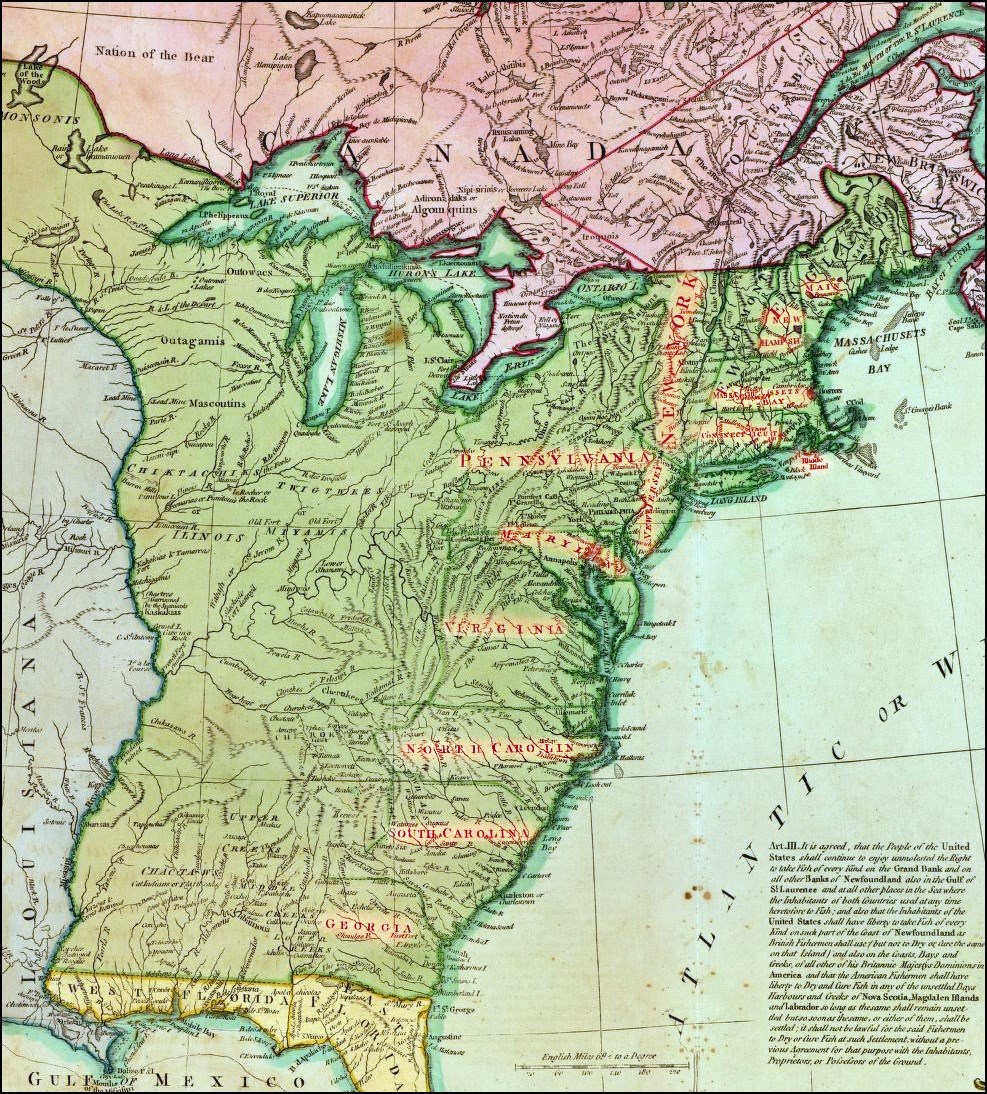
The United States territory, shown in green, at the end of the Revolutionary War. Before 1800, the U.S. did not have a permanent capital city. The president, Congress, and the Supreme Court met in different cities in the northeast until the government moved to Washington, D.C.
Questions for Map 1
1) Locate and name the original 13 states on the eastern coast.
2) If you could choose the location for the capital of the United States of 1783, where on this map would you place it? Why?
3) Would you choose to build a capital city from the ground up or choose to turn an existing city into a capital? What do you think would be the advantages and disadvantages for founding a new city?
4) Americans chose land on a river that creates the border between Maryland and Virginia to build a new capital city. Find this region on the map. What do you think the benefits would be to have a national capital at this place?
5) Who do you think would benefit the most from a capital between Maryland and Virginia? Who do you think would be disadvantaged? Why?
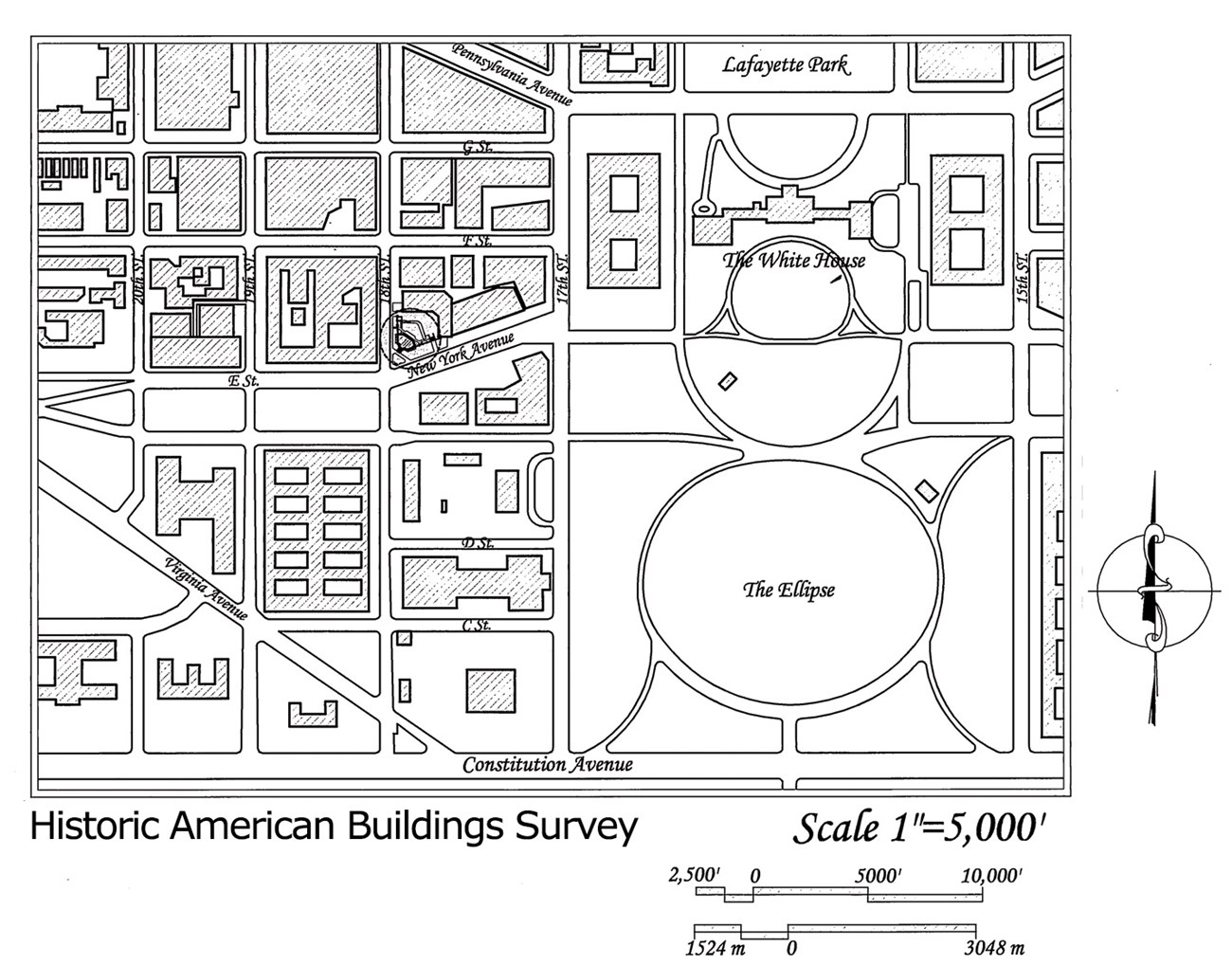
Shaded areas represent buildings. The Octagon house (circled) is located at the corner of 18th St. and New York Avenue, west of the White House.
Map 2b: The Octagon house (from Map 2a).
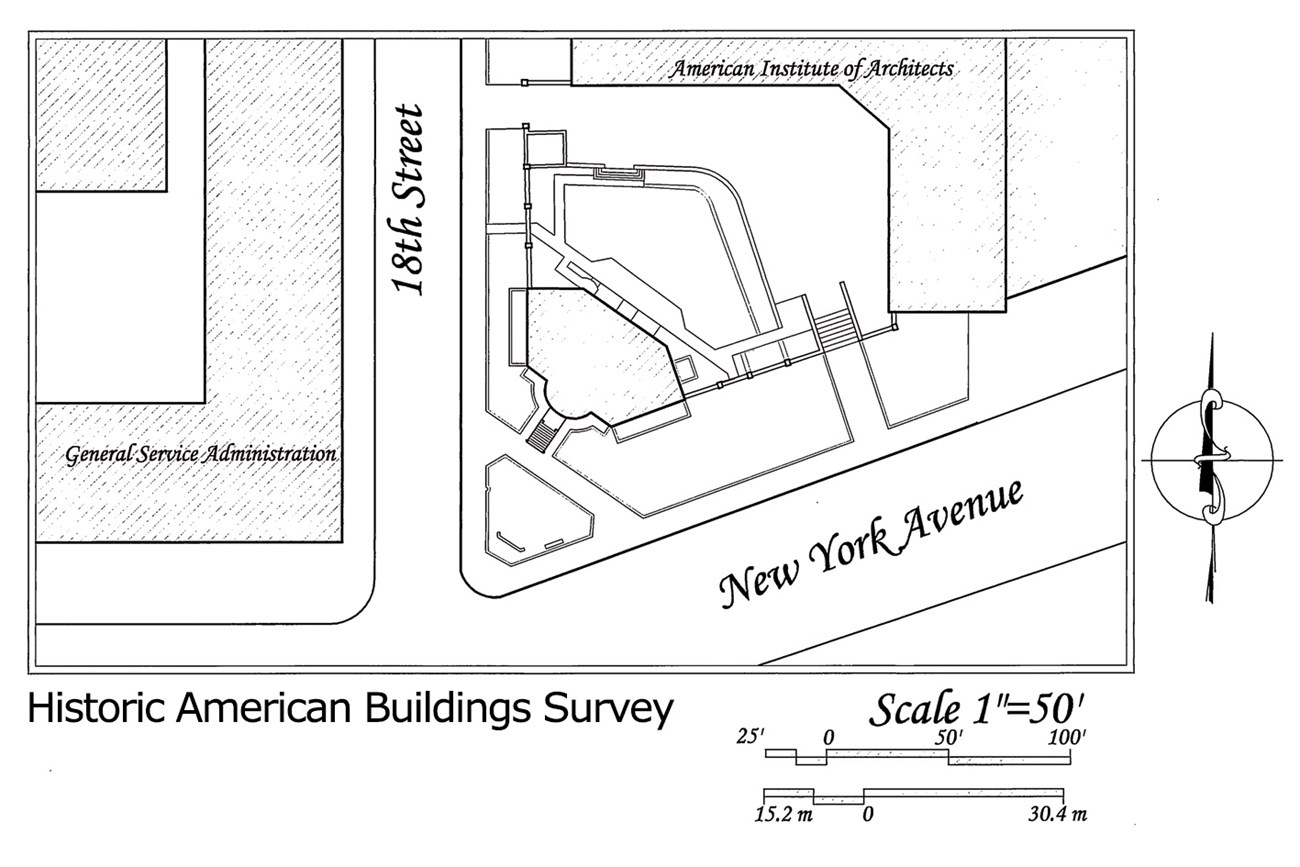
Questions for Map 2a and Map 2b
1) What kind of landscape does Map 2a show? Urban or rural? What evidence supports your answer?
2) Does this neighborhood look like a place where people have their homes or a place where people go to work? Explain your answer.
3) From what you see in Map 2a, what shapes are most of the lots? What shape is the lot The Octagon was built on? What challenges do you think an architect faced when designing The Octagon?
4) Why do you think someone would want to live at The Octagon?
Determining the Facts
Reading 1: A Capital City Founded by Compromise
Washington, D.C., is a city founded on a compromise. During the Revolutionary War, American states each went into debt when they borrowed money to pay for the war with England. By 1790, states in the south had paid off most of their debt, but northern states had not. Many northerners wanted the federal government to pay off the states’ Revolutionary War debts with taxes. This did not seem fair to southerners. At the same time, the federal government did not have a permanent capital and members of Congress could not agree on a location. The Compromise of 1790 settled both the issue of debt and the capital.
The representative body that became the U.S. federal government met in eight different cities in Pennsylvania, New York, New Jersey, and Maryland between 1774 and 1800. By 1790, Americans wanted a permanent capital. The United States Constitution gives Congress the power to create a capital district separate from the states. The Constitution does not say where Congress will create the district. Politicians knew that the states bordering the district would be able to influence the capital. Influence in the capital meant influence in the government. This gave the northern states something to bargain with when they asked the South to help pay off their wartime debts. Northerner Alexander Hamilton, who was Secretary of the Treasury, made sure congressmen from northern states voted to put the capital in the South. James Madison and Thomas Jefferson, who were from the South, made sure that southern congressmen voted to have the federal government pay off the states’ debt. The Residence Act of 1790 passed because of this compromise.
The Residence Act gave the president power to select land in Maryland, on the eastern bank of the Potomac River, to establish the capital city. President George Washington chose a site that included existing river ports known as Alexandria and Georgetown. The land was not developed, except at the ports. There were fewer than 800 people living in the portion of the District known as the City of Washington at the time. Most of the residents were enslaved and worked on large farms. The commissioners named the city a year after the Residence Act passed. They named the district “Columbia” after Christopher Columbus, the Portuguese explorer who began European colonization of the Americas in the 1490s.
The president asked Peter L’Enfant to design the city. L’Enfant was Washington’s friend and a Revolutionary War veteran. He was also an artist who lived in Paris, France, before he moved to America. L’Enfant had a grand vision for the city. He planned for the city to have wide avenues and large, open spaces for public parks and monuments. Congress would meet in the capitol building located a mile away from the President’s House. L’Enfant wanted the land around government buildings to be private home lots for foreign dignitaries and ambassadors, as well as prominent and powerful Americans.
Washington’s and L’Enfant’s ambitious plans for the District of Columbia faced challenges. The construction work was slow. D.C.’s city commissioners argued over planning details with architects and planners. The commissioners also had trouble raising money for the project. The construction of the city was supposed to be paid for by auctioning off lots of land within the city to private buyers. This was not as successful as they had hoped. There were not as many buyers as they had expected.
Another problem was the city commissioners’ preference for using enslaved laborers in the construction projects. L’Enfant and others did not want slavery in the capital. The system of slavery was widespread in the South and Washington, D.C. was founded in the southern state of Maryland. In the late 18th century, northern states like Pennsylvania and Massachusetts abolished slavery and new territories in the west were created with laws against slavery. The new capital district kept it legal when it separated from a slave state.
Construction of the capitol building did not finish by 1800, but Congress did move to D.C. that year. The population increased and construction continued, but growth was slow. Senator Morris of New York state joked that the capital had everything except "houses, cellars, kitchens, well-informed men, amiable women, and other little trifles of this kind."1 In the early 19th century, Washington, D.C. was called “the city of magnificent distances” and “the city of streets without houses.”2
Questions for Reading 1
1) What was the Compromise of 1790? What did the two sides each want? What was the result of the compromise?
2) Why do you think the Framers of the Constitution wanted the capital in an independent district?
3) According to the reading, in what ways did slavery affect the creation of Washington, D.C.? What do you think were some of the ways a capital city with slavery supported slavery throughout the U.S.?
4) Why do you think people would be reluctant to move their homes and businesses to Washington, D.C. in 1800? Why would people be eager to move there?
1 Byrd, Robert and Wendy Wolff. The Senate, 1789-1989: Addresses on the history of the United States Senate, Volume 1. Washington, D.C.: Government Printing Office, 1988. 405.
2 National Register of Historic Places, L'Enfant Plan of the City of Washington, District of Columbia, Washington, D.C., National Register #97000332. 13.
Determining the Facts
Reading 2: An Introduction to The Octagon
Colonel John Tayloe III and his family were among the first of America's wealthy, ruling class to settle in the new capital of Washington, D.C. Their new house in the capital was a second home at first. The Tayloes already owned Mount Airy, a large Virginia farm where Tayloe bred racehorses. In the late 1790s, he wanted to build a grand winter home where he could host events and entertain other important and powerful people in the capital. But before he purchased land in Washington, John Tayloe III considered moving to Philadelphia, Pennsylvania, or Annapolis, Maryland. Philadelphia was the U.S. capital before Washington, D.C., and Annapolis was the state capital of Maryland. It was also the birthplace of his wife, Anne Ogle Tayloe. George Washington, a family acquaintance, recommended the new capital city and John Tayloe III agreed.
Early Washington was divided into Squares and the Squares were divided into Lots, which could be sold to private citizens. Tayloe paid $1,000 for Lot 8 in Square 170. Lot 8 is between New York Avenue and 18th Street. These are two important routes through the city. In 1800, the land Tayloe bought sat on a bluff overlooking the Potomac River and Tiber Creek, or in in the direction of the National Mall today. From there, people in the house could see the city’s landscape and people in the city could view the house. This was a desirable location. However, the acute angle formed by the intersection of New York Avenue and 18th Street was a challenge for architects.
John Tayloe talked to two well-known architects about a design: Benjamin Henry Latrobe and Dr. William Thornton. Both men were qualified to build a grand home. Latrobe was the architect who designed the President’s House and later worked to design the Capitol Building. Thornton was the first Architect of the Capitol. Tayloe’s architects both wanted to design a Federal Style house to face the street at that location, but Latrobe’s design did not work with the location of the house. The design had a lot of symmetrical angles and features, which were popular with elite homes of the era but would not work with the lot. Tayloe decided to hire Thornton. Thornton’s creative design was for a house that worked with the angle of the streets and the shape of the lot.
Dr. William Thornton arrived in Washington, D.C. in 1793. He was born in the British colonies in the West Indies and earned a medical degree in Scotland. He was also an inventor, painter, poet, and architect. Thornton wrote articles on different topics including astronomy, philosophy, language, medicine, art, and government. His design for The Octagon is an example of his creativity and problem-solving abilities. His first designs for the lot were awkward, but his final design was for a grand home that could be a place for family life and social events, but also a place that fit into the unusually-shaped lot and L’Enfant’s plan for the streets.
Construction began in 1799 and finished in 1801. The house cost John Tayloe $35,000. In 1801, an “amity button” was placed in the large post at the foot of the main staircase. An amity button is a small ivory button. Its placement in the bottom post (called a “newel post”) meant that the owner of the house and the builder of the house finished business on friendly terms. The Tayloes moved to Washington, D.C. in the fall of 1801. The Tayloes supplied themselves and their free servants, enslaved servants, and guests with food from their nearby farm, called Petworth. The family also purchased food from the local market, shops, street vendors, and auction sales of produce from ships.
The Tayloes lived and entertained guests at the house during part of the year for roughly 15 years with one major interruption. In 1814, during the War of 1812, President James Madison and his wife Dolley moved into The Octagon. The British invaded Washington, D.C, on August 24, 1814. They looted and burned public buildings, including the President’s House and the Capitol. John Tayloe offered his home to the First Family after the British left the city and they accepted. The Madisons moved into The Octagon on September 8th, 1814 and stayed until March 1815. The president ran the government and the First Lady, Dolley Madison, continued to host parties. Their occupation of The Octagon told the nation that the president refused to give up on the burned capital city. The War of 1812 ended during their stay. President Madison signed the Treaty of Ghent in The Octagon’s second-floor parlor, the circular room above the entrance hall. This treaty officially ended the war between Britain and the United States.
The Tayloes decided to live at The Octagon year-round sometime between 1815 and 1817. John Tayloe died in 1828. His wife, Anne, lived in the house until she died in 1855. Afterward, The Octagon was used as a Catholic school, government office space, and private apartments. The American Institute of Architects bought it in 1902. Today, the American Institute of Architects Foundation operates the house as a museum.
Questions for Reading 2
1) Colonel Tayloe was known as one of the richest men in Virginia in the late 18th century. What evidence is there of this in Reading 2?
2) According to the reading, why did Colonel Tayloe hire Dr. William Thornton to design his house? What design challenge did Thornton overcome?
3)Who lived at The Octagon between 1800-1815? What different roles did these people play in D.C. society?
4) Could the Tayloes and Madisons have been just as successful living in a one-room log cabin? Why or why not?
Determining the Facts
Reading 3: Life in The Octagon
This is a letter written by William Henry Tayloe (1799-1871), to his son Henry Augustine Tayloe (1836-1908). William Henry Tayloe was Colonel John Tayloe III’s son and was born in 1799, the year work on The Octagon began.
Am (an) Account of The Octagon
Written by my father at my request 1870
H.A Tayloe of Mt. Airy
My dear Harry
The Octagon was built by your Grand Father in the administration of President Washington who took much interest & frequently walked to examine its progress. He had much to do with its location. Dr. William Thornton drew the plan. It fronts on the comer of New York Avenue & 18th Street. Ascending steps with Iron rails to a Portico, there is a large Circular Hall with Marble floor, heated formerly with two Imported Coal Stoves - with a Hat & Coat closet on one side. Passing under an Arch supported by Columns is the main passage with a beautiful Winding Stair way to the top of the house. Near there between on the right, is the door (mahogany) into the Drawing Room 30+20 on 18 Street. A private Stairs run back of the Dining room from the basement to the upper floors. In the basement is the House Keepers room, Store rooms, Wine Cellar, Servants Hall, Kitchen with a Well of fine water and pump in it (at that time). On the second floor the Circular room over the Hall way, the Library with two closets with Windows. Two chambers over the Dining room & one over the Drawing room, also Linen and Clothes closets. Five chambers & large closets are in the third story. Formerly the roof was flat, with a Wall relieved by Stone work. The view from the top of all Washington City & surroundings with Alexandria in the distance is most beautiful; but the roof leaked. Hadfield Architects Downing Carpenter put on the present roof which is ugly.
The Garden is inclosed with a Brick wall -with Pillars caped with Stone. In is rear is a two Story House for the Laundry & Servants rooms - the Stable yard paved & in it a Well of good Water. The Stable is a long two Story Building on the back lines of the lots - a commodious Carriage in the Center - the Coach Horse Stable on one side & the Saddle House and Phaeton Horses on the other side. Your GrandFather had his Phaeton & praise [?] & one sometimes two Saddle horses for his own use - in Archy Nashs care. Your Grandmother had the Coach & four Bays with and odd horse in case of lameness. Harry Jackson Coachman. Gowen Lawson Footman. There is a long brick shed beyond the Stables with Cow Stables. Â Horse Box & Pounting rooms - also a Smoke & Meat house. The Ice House is on 18th Street with a Store room over it.
The Col. imported the Furniture except the Sideboard & some heavy articles which were made at Annapolis Maryland. Clothing, Books & Shoes Harness Saddles & Bridles and Wines.
After the English burnt the Presidents House President Madison moved into The Octagon. Mrs. Madison taking with her Stewarts painting of Washington she had cut out of its frame. Your Aunt Mrs. Anne Ogle Lewis now has the Table on which the Treaty of Peace between England & the United States was signed.
The Servants wore Blue Quaker Cut Coats turned up with Red Collars and Pockets gold laced. Red Vests- Breeches, Whitest long stockings, Shoes & Buckles,- in full costume shoulder straps or small Epaulettes.
Your Grand Mothers nurse was a White woman born in Philadelphia. She lived to nurse all the Children of your GrandMother & died in The Octagon honored. A monument is over her grave.
Questions for Reading 3
1) Who wrote this letter and why do you think he wrote it? What does it describe?
2) Based on Readings 2-3, roughly estimate how many people you think lived at The Octagon estate in the early 1800s. How many were family? How many do you think were servants?
3) Why do you think The Octagon has a “beautiful winding stair way to the top of the house” and also a “private stair” that goes to the basement. What people mentioned in the letter do you think would have used the “beautiful” stair in the front hall? Who in the letter would use the private stair? Why?
4) Using information from the letter, why do you think President Madison and the First Lady chose to stay at The Octagon? (Refer to Reading 2 and Map 2 if necessary)
Reading 3 is excerpted from a letter in The Octagon Museum Archives.
1 "30+20" refers to the dimensions of the room.
Determining the Facts
Reading 4: The Octagon in Early D.C.
Benjamin Ogle Tayloe, eldest son of Colonel John Tayloe III, wrote the following excerpted paragraphs in 1864. They are part of his memoir, Our Neighbors on La Fayette Square: Anecdotes and Reminiscences by Benjamin Ogle Tayloe, published 1872. Benjamin Tayloe was born in 1796.
I write of neighbors, and of anecdotes connected with them, for the gratification of my family. It is hardly necessary to inform them that their paternal ancestors lived in the Northern Neck of Virginia, between the Rappahannock and the Potomac, the native land of Washington, the Lees, Madison, and Monroe, until my father came to Washington City, in 1800, and took possession of his new house, The Octagon, at the intersection of New York Avenue and Eighteenth Street. He had been induced by his hereditary friend, General Washington, to erect his town house in the Federal city, having previously had an eye to Philadelphia. Friendly to the object, and taking a lively interest in the erection of a house to be greatly superior to any other private mansion in Washington, the General frequently watched the progress of the work, from his horse, when he visited the embryo city, in 1798 and 1799, as reported to me by the late Charles Coltman, a wealthy citizen, recently deceased, and then a boy working with his father, a brickmason, upon the house. George Washington had himself erected a town house on Capitol Hill, which is still standing, and is now the property of Admiral Wilkes.
I came to Washington in 1801, and remember it literally as rus in urbe, containing but a few thousand inhabitants, scattered about in single houses, apart from each other, or in occasional groups, chief in the vicinity of the public buildings, from Georgetown to the Navy Yard. There was scarcely any pavement, except in front of detached houses. The distinguished John Cotton Smith told me that when he was a Senator from Connecticut, he attended President Adams’s first levee [a formal party] in Washington, in 1801, and that the members if Congress living, like himself, on Capitol Hill, found it necessary to send to Baltimore for hackney coaches to convey them to the President’s house; and to avoid the swamp of Pennsylvania Avenue, they had to travel along F street and the high grounds adjacent. (During Mr. Monroe’s administration, I have seen carriages mired in Pennsylvania Avenue, even then almost impassable, the city at that time having less than ten thousand inhabitants.)
Mr. Madison appropriately did the honors of the White House, until expelled from it by the British invasion, in August 1814. The Capitol, the President’s house, the public buildings, and a few private houses, were burned by the “vandals,” as they were termed, under Admiral Sir George Cockburn and General Ross, who, within a month, was killed on the repulse of the British at North Point, near Baltimore. At this time my father was in command of the cavalry of the District. Superseded by an officer of the regular army, he was sent to Virginia to bring up some of its militia in season to aid in the defense of the Capital. His efforts proved ineffectual, and he was returning home, when he met my mother on the road, making her way to his place, Neabsco, near Dumfries, in Virginia. She had vacated The Octagon, and induced Mons. Serrurier, the French Minister, to occupy it, with a view to its protection. After going to Virginia, my parents divided their time between Neabsco and Mount Airy, until they reoccupied their own house, on its being vacated by Mr. Madison, after the war. For the nonce, until another house could be prepared for him, Mr. Madison was the occupant of The Octagon, and there he signed the treaty of peace with Great Britain, in the circular room over the entrance-hall, in February, 1815.
Questions for Reading 4
1) Who wrote this letter? How old was he in 1801, 1815, and 1864?
2) What kinds of buildings does Benjamin Tayloe mention in this document? What kinds of people lived or worked in these buildings?
3) “Rus in urbe” translates from Latin to “country in the city." Why did Benjamin Ogle Tayloe use this term to describe D.C.?
4) Do you think this memoir is a reliable source of information? How is it trustworthy? Where could you look to check Tayloe's claims?
Reading 4 was excerpted from Our Neighbors on La Fayette Square: Anecdotes and Reminiscences by Benjamin Ogle Tayloe, published in 1872 by the Junior League of Washington, D.C.
Visual Evidence
Painting 1: "A view near the President's house in the City of Washington," 1813, by S. Lewis.

The Octagon is the building on the right of the painting, behind tall trees.
Questions for Painting 1
1) Describe the scene in the painting. What kind of place is this?
2) Describe The Octagon. How many stories do you think it is? What kind of materials do you think it is made from?
3) Compare The Octagon to other buildings in the painting. How is it similar to the other houses? How is it different?
4) Compare this image to Map 2. From what you see, how did the city of Washington change in 200 years? What did not change?
Visual Evidence
Drawing 1: Plans of The Octagon's First and Second floors.
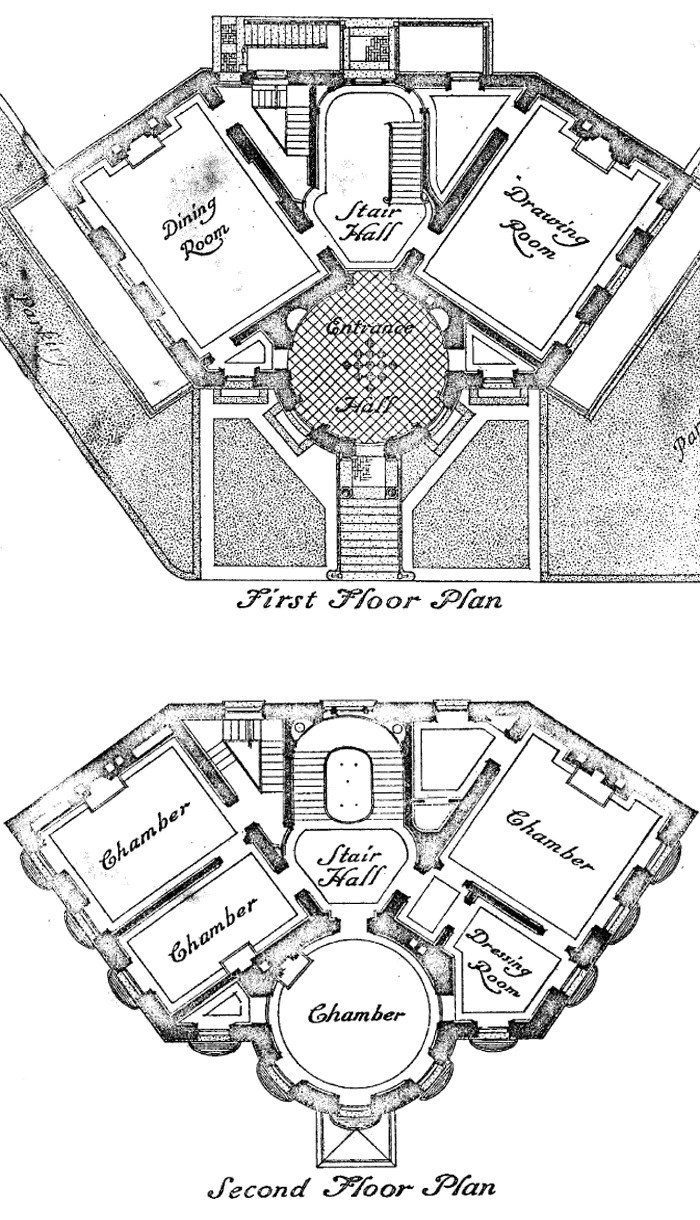
The Octagon has a basement, three main stories, and an attic. A “Drawing Room” is a formal lounge where visitors can gather and socialize.
Questions for Drawing 1
1) Compare the first and second floors. What room is directly above the Entrance Hall? What rooms are directly above the Drawing Room? What rooms are above the Dining Room?
2) First Lady Dolley Madison is known for hosting regular social gatherings for important people in Washington, D.C. She did not want to stop entertaining important people after the White House burned. Why was The Octagon a good temporary replacement for the President's House?
3) Compare the place where you live to The Octagon. How is your home different from the Tayloe’s and the Madison’s Octagon? How is it similar? How does the building you live in help create an identity for your community?
Visual Evidence
Photo 1: The Octagon Dining Room.
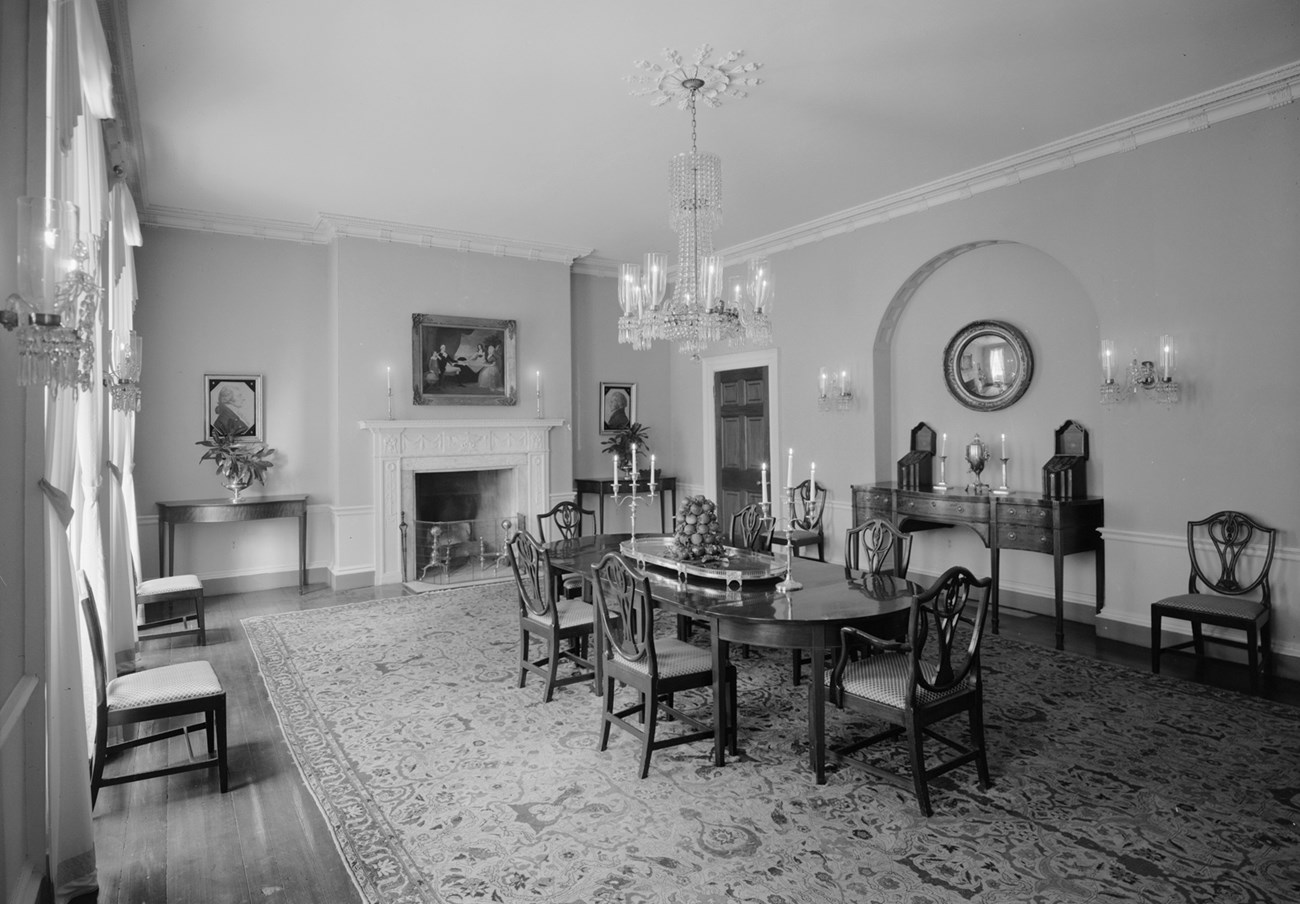
The Octagon Museum recreated the dining room with some of the Tayloe family’s original furnishings and other decorations from the early 19th century.
Questions for Photo 1
1) What features, decorations, and art do you see in this room? Give some examples.
2) What individuals or families mentioned in Readings 1-4 may have dined in this room? What people mentioned in the readings would not have dined in this room? Why not?
3) What chores do you think The Octagon’s servants and enslaved residents have to do before the Tayloes could entertain in this room? What evidence supports your answer?
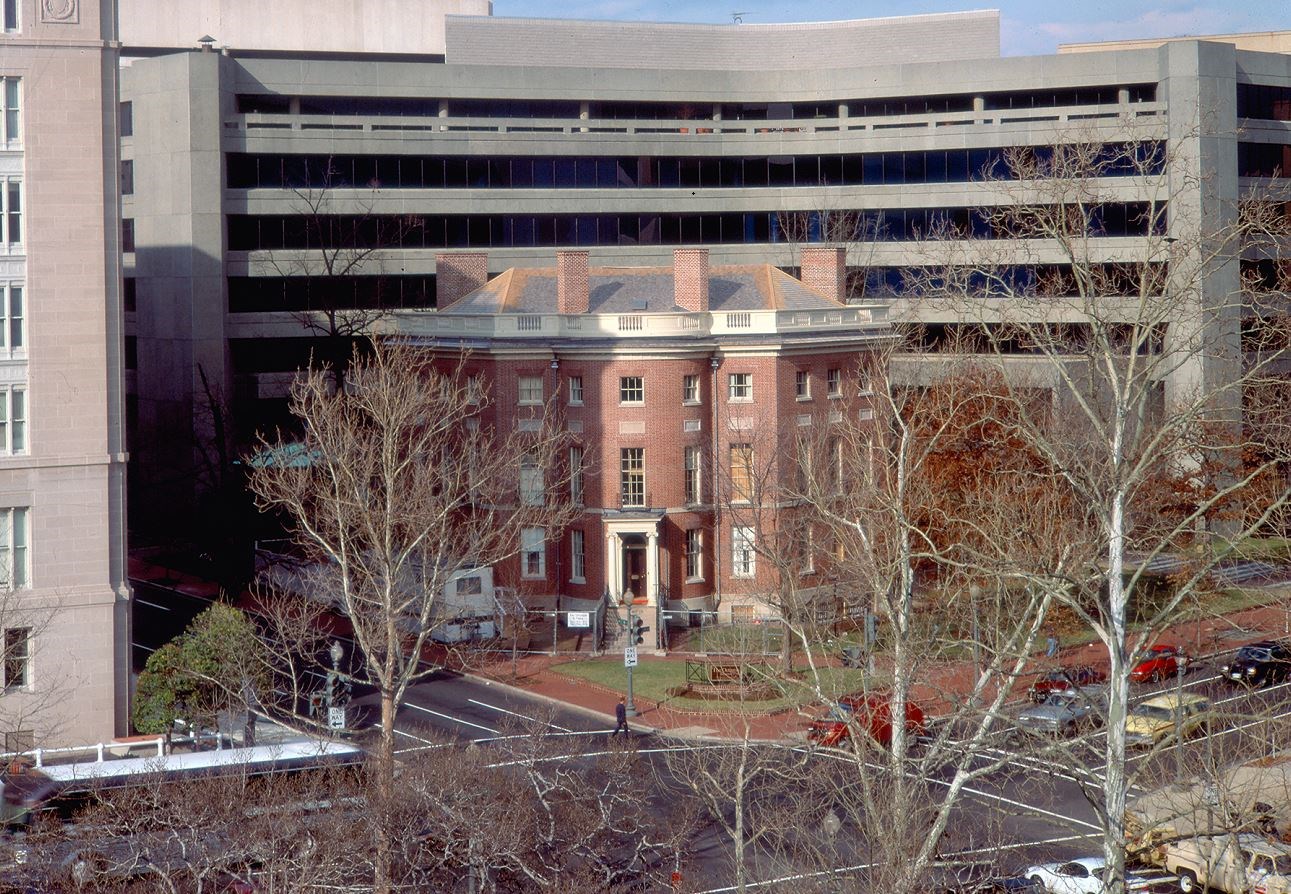
Questions for Photo 2
1) Compare The Octagon to the buildings around it. How is The Octagon different?
2) The large building behind The Octagon is the headquarters of the American Institute of Architects. The AIA Foundation owns The Octagon. What reasons might members of the American Institute of Architects have for wanting their headquarters at The Octagon?
3) Do you think Colonel John Tayloe III would recognize the place in Photograph 2? Why or why not? (Refer to Painting 1 and Readings 2-4 if necessary)
Putting It All Together
The Octagon was one of the first signs of grandeur and growth in Washington, D.C. at the beginning of its 200+ years of development and expansion. Studying its history provides an excellent starting-off point to understand the society of early Washington, D.C., and the politics surrounding the city’s creation. Use the following activities with your students to expand on what they learned.
Activity 1: The Capital Decision
Lead a class discussion on the regional tensions that were at stake in the compromise that led to Congress’ decision to move the capital to D.C. Then, break students into groups. Each group should work together to create a table. On one axis, they should list the following people:
-
A politician from Pennsylvania who was not opposed to the existence of slavery in the southern states.
-
A plantation owner from South Carolina. Notable southerners wanted the capital located in the slaveholding southern region.
-
A politician from Virginia. All southern politicians at this time supported slavery.
-
A businessman from New York who opposed slavery.
On the other axis, they should list these questions:
- What characteristics would this person value in the location for the new capital city?
- What did this person have to lose or gain from the decision to move the capital to D.C.?
- Would this person have been satisfied with the decision to move the capital to D.C.?
Students should review Reading 1 and a map of slave and free states for help in completing their tables.
Tell students that the people they considered in their table represented the people who weighed in on the compromise. Whose voices were left out of the decision-making process?
Activity 2: The Buildings that Built Your Town
Have students research the decisions or events that led to the founding and expansion of their own community. Ask them to identify historic houses or buildings still standing today that played a key role in their community’s early development. Ask them why they think the building is important and how it influenced growth. Hold a classroom discussion asking student opinions on why it is important to preserve historic places like The Octagon and any local historic places students brought up. Let students know that by the late 1800s The Octagon had fallen into severe disrepair, but was then preserved under the stewardship of the American Institute of Architects. Ask students about any buildings or places in use today that they think should be preserved for historic importance and study 50, 100, or 200 years in the future.
Break students up into small groups. Tell each group to choose an historic place in their community they think is important to preserve. Have each group create a poster or display board campaigning to preserve this landmark. If it is possible, they should visit the site and have a photograph taken of them at the place. They can include the photograph in their poster or display. After each group presents its historic place and display, have the class vote on one place to campaign for as a class. Have the class prepare the documentation to nominate the historic site to the National Register of Historic Places if it is not already listed or nominate the place to the National Trust for Historic Preservation This Place Matters program by submitting a class photo at the site.
Activity 3: Imagining the 19th Century
Divide students into groups and assign each group a diffferent event that occurred at The Octagon.
- When construction on The Octagon started in 1799
- The completion of The Octagon in 1801 and moving in
- The burning of Washington by the British
- The signing of the Treaty of Ghent
- John Tayloe’s death in 1828
Ask each group to discuss how the different people living and working at The Octagon--the Tayloes, their free servants, and the people they enslaved--may have experienced each event. Students may want to review the readings for use in their discussion.
The Octagon of Washington, D.C.: The House that Helped Build a Capital --Supplementary Resources
Those interested in The Octagon, the history of Washington, D.C., grassroots historic preservation, and the War of 1812 can access additional resources online. Here is a selection of websites that students and educators may find helpful.
The Octagon Museum
The American Institute of Architects Foundation owns and operates The Octagon Museum at the historic Octagon house. Visit this official website to plan a tour, sign up for Octagon news alerts, discover special events, and find out more about the American Institute of Architects.
Paul Jennings
PaulJennings.info provides information about Paul Jennings, an enslaved African American and member of President Madison's personal serving staff during the early 19th century. As a free man and government employee in the 1860s, he authored A Colored Man’s Reminiscences of James Madison.
Birth of the Nation: The First Federal Congress 1789-1791
Hosted by the George Washington University, this online exhibit is based on a traveling exhibit first opened in 1989. The online version includes resources about the First Federal Congress, including the Compromise of 1790, the Residence Act, and the Funding Act.
Tags
- historic preservation
- dc history
- washington d.c.
- presidential history
- national register of historic places
- nrhp listing
- teaching with historic places
- twhp
- art and education
- federal
- american president
- american presidents
- james madison
- dolley madison
- war of 1812
- military history
- white house
- colonial
- slavery
- paul jennings
- burning of the white house
- burning of washington
- america 250 nps
- 250
- washington dc
- twhplp
- america 250
